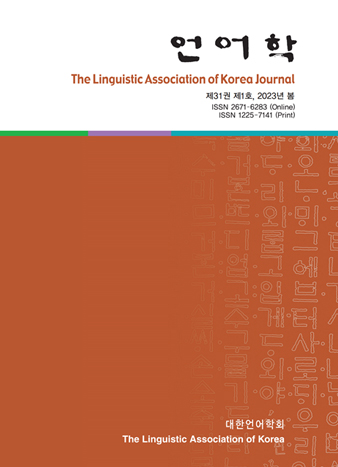대한언어학회 전자저널

31권 1호 (2023년 3월)
Abstract
Cho, Seungyeon. (2023). Comparative study of feminine and masculine languages of human translation and machine translation: Focused on the sentence-end expressions in the Japanese translations of the Korean novel Kim Jiyoung, Born 1982. The Linguistic Association of Korea Journal, 31(1), 45-63. This study is a case study of machine translation in literature, which is performed by applying two types of machine translations (Google and Papago) to the novel Kim Jiyoung, Born 1982. The purpose of this study is to examine the applicability of machine translation in literature. To this end, we have looked at the usage patterns of the sentence-end expressions in female and male characters of the human-translated Japanese novel and how those sentence-end expressions appeared in machine translations. This study is not for evaluating mistranslations and performance in machine translation in literature. As a research method, we constructed the texts of the Korean novel and the Japanese translation as a corpus, and performed a cross-analysis (chi-square test) with the analysis data. Also, we contrasted human and machine translations by analyzing the sentence-end expressions of the characters according to 有泉 (2016)'s seven classification methods of sentence-end expressions. The study results show that both types of machine translations translated the female characters' sentence-end expressions to a level close to human translation.
Keywords
# 문학기계번역(Literature translation) # 여성어(female language) # 남성어(male language) # 코퍼스 분석(corpus analysis)
References
- 곽은심. (2014). 韓国小説の日本語翻訳に見られる女性登場人物の言葉遣いに関する一考察-女 性ジェンダ-標示形式の使用を中心に-. 일본문학학보, 64, 5-28.
- 곽은심. (2015). 韓日幡譯授業における文末表現の指導に關する硏究 -性差を表す文末詞の使用 を中心に-. 일본어교육연구, 7-28.
- 김슬기. (2018). 인공지능으로 날개 단 자동통번역 서비스. Digieco. KT경제경영연구소. Retrieved from http://digieco.co.kr/ktfront
- 마승혜. (2017). 기계화되기 어려운 인간 능력과 문학번역 능력 비교 고찰 및 논의. 통번역학연구, 21(3), 55-77.
- 마승혜. (2018). 문학작품 기계번역의 한계에 대한 상세 고찰. 통번역학연구, 22(3), 65-88.
- 안미영. (2020). 한국어와 영어의 언어적 차이에 따른 기계번역의 문제점과 그에 대한 포스트 에디팅 방향 제안. 영어영문학, 25(1), 103-130.
- 이상빈. (2016). 트랜스크리에이션, 기계번역, 번역교육의 미래. 통역과 번역, 18(2), 129-152.
- 이용훈. (2016). R을 활용한 코퍼스언어학과 통계학. 한국문화사.
- 이유아. (2020). 소설 82년생 김지영의 번역에서 나타난 젠더 표현 양상에 대한 고찰. 일본어문학, 88(1), 149-178.
- 이준호. (2019). 문학번역 적용을 위한 기계번역의 현주소. 통번역학연구, 23(1): 143-167.
- 이창수. (2021). 기계학습 알고리즘을 활용한 문학번역에서의 기계 번역과 인간 번역 결과물 분류 연구. 번역학연구, 22(1), 199-217.
- 이해미. (2022). 국내 언어학계와 일본어학계의 기계번역 관련 연구 동향 분석. 일본어학연구, 71, 125-143.
- 탁성숙. (2002). 문말표현에 관한 연구. 보고사, 13-21.
- 최윤영. (1996). 기계번역과 문학번역. 번역연구, 4, 51-61.
- 황수영. (2015). 한국인 일본어 학습자에 있어서의 문말표현에 관한 양상 연구 : 종조사와
- 중도종료표현, 추량표현을 중심으로. 일본어교육, 72-81
- 有泉優里. (2013). 会話文末における「男ことば」と「女ことば」の分類-ジェンダー識別 傾向とジェンダー特異性を指標として-. 日本語とジェンダー, 13, 63-72.
- 奥田亜未. (2016). 채팅에서의 일본인 여성 젠더표현 사용경향에 관한 연구 –문말표현을 중심으로–. 일본어교육연구, 139-156.
- 小川早百合. (2004). 話し言葉男女差-定義・意識・実態.日本語とジェンダー, 4, 25-39.
- 尾崎喜光.( 1997).「 女性専用形式のいま」現代日本語研究会編『 女性のことば-職場編-』ひつじ書房.
- 中島悦子 (1999). 女性の言葉・職場編 ひつじ書房.
- 林明子. (2005). ジェンダーによる日本語表現のヴァリエーション-若年層の用いる発話末 の表現形式と音声的特徴-. EAJS (European Association for Japanese Studies), 43.
- 水本光美. (2005). テレビドラマにおける女性言葉とジェンダ-フィルター. 日本語ジェン ダー学会学会誌, 5, 23-46.
- 水本光美. (2007). 主張どの強い場面における女性文末詞使用-実際の会話とドラマとの比較 -. 国際論文第五号, 北九州市立大学, 13-22.
- 水本光美. (2008). ドラマに使われる女性文末詞-脚本家の意識調査より. 日本語とジェン ダー8, 73-94.
- Hutchins, J. (2005). Current commercial machine translation systems and computer-based translation tools: system types and their uses. International Journal of Translation, 17(1-2), 5-38.
- Toral, A., & Way, A. (2015) ‘Machine-assisted Translation of Literary Text: A Case Study’, Translation Spaces, 4, 241-268.
- Toral, A., & Way, A. (2018) What level of quality can neural machine translation attain on literary text?. arXiv preprint arXiv, 1801, 04962.
- Voigt, R., & Jurafsky, D. (2012). Towards a literary machine translation: The role of referential cohesion. In Proceedings of the NAACL-HLT 2012 Workshop on Computational Linguistics for Literature, 18-25.